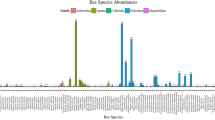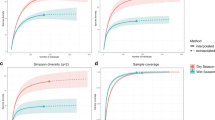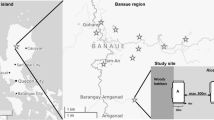Abstract
Buzz-pollinated plants are an essential source of pollen for a significant portion of local bee communities. Buzz pollination research has focused on studying the properties of bee buzzes and their implications on pollen release, morphological specialization of flowers, and the reproductive ecology of buzz-pollinated plants. In contrast, diversity patterns and ecological interactions between bees and buzz-pollinated plants have been studied less. This study analyzed the buzzing bee community of twelve tropical buzz-pollinated co-occurring plant species in a tropical montane cloud forest during the flowering periods of two consecutive years, focusing on diversity, compositional similarity, structure, and specialization (H2´) of the network. Twenty-one bee species belonging to Apidae, Colletidae, and Halictidae were recorded, fifteen species in 2014, and eighteen in 2015. Floral display and visited flowers doubled from first to second year, although the flowering period was 2 months longer in the first year. Bee compositional similarity between plants tended to be low; however, this was due rather to a high nestedness than species replacement. Temporal bee compositional similarity was also low but variable, and different plant species showed the highest similarity between years. The number of bee visits depended significantly on the number of flowers and years. Interactions between bees and plants showed a tendency to generalization. Compared to other buzz-pollinated networks, specialization (H2´) was similar, but diversity was low and the network small. In endangered ecosystems like the Mexican cloud forest, however, buzzing bees support biodiversity and provide an essential ecological service by pollinating dominant understory flora.





Similar content being viewed by others
References
Abramson G, Trejo Soto CA, Oña L (2011) The role of asymmetric interactions on the effect of habitat destruction in mutualistic networks. PLoS One 6:e21028
Alarcón R, Waser NM, Ollerton J (2008) Year-to-year variation in the topology of a plant–pollinator interaction network. Oikos 117:1796–1807
Almeda F (1993) Melastomataceae. Fascículo 10:1–38. Flora del Bajío y de Regiones Adyacentes. Instituto de Ecología, AC, Pátzcuaro
Almeida-Neto M, Guimaraes P, Guimarães PR, Loyola RD, Ulrich W (2008) A consistent metric for nestedness analysis in ecological systems: reconciling concept and measurement. Oikos 117:1227–1239
Arceo-Gómez G, Martínez M, Parra-Tabla V, García-Franco J (2011) Anther and stigma morphology in mirror-image flowers of Chamaecrista chamaecristoides (Fabaceae): implications for buzz pollination. Plant Biol 13:19–24
Arceo-Gómez G, Martínez ML, Parra-Tabla V, García-Franco JG (2012) Floral and reproductive biology of the Mexican endemic Chamaecrista chamaecristoides (Fabaceae) 1. J Torrey Bot Soc 139:260–269
Armbruster W (2017) The specialization continuum in pollination systems: diversity of concepts and implications for ecology, evolution, and conservation. Funct Ecol 31(1):88–100
Armbruster W, Fenster C, Dudash M (2000) Pollination “principles” revisited: specialization, pollination syndromes, and the evolution of flowers. Det Norske Videnskaps Akademi. I. Mat. Naturv. Klasse. Skrivter. Ny Serie 39:179–200
Arroyo-Correa B, Beattie C, Vallejo-Marín M (2019) Bee and floral traits affect the characteristics of the vibrations experienced by flowers during buzz pollination. J Exp Biol 222(4). https://doi.org/10.1242/jeb.198176
Bascompte J, Jordano P (2007) Plant-animal mutualistic networks: the architecture of biodiversity. Annu Rev Ecol Evol Syst 38:567–593
Bendel CR, Kral-O'Brien KC, Hovick TJ, Limb RF, Harmon JP (2019) Plant–pollinator networks in grassland working landscapes reveal seasonal shifts in network structure and composition. Ecosphere 10(1):e02569. https://doi.org/10.1002/ecs2.2569
Bernhardt P (1996) Anther adaptation in animal pollination. In: D’Arcy WG, Keating RC (eds) The anther form, function and phylogeny. Cambridge University Press, New York, pp 192–220
Bezerra E, Machado I, Mello M (2009) Pollination networks of oil-flowers: a tiny world within the smallest of all worlds. J Anim Ecol 78:1096–1101
Blüthgen N, Menzel F, Blüthgen N (2006) Measuring specialization in species interaction networks. BMC Ecol 6:9
Blüthgen N, Menzel F, Hovestadt T, Fiala B, Blüthgen N (2007) Specialization, constraints, and conflicting interests in mutualistic networks. Curr Biol 17(4):341–346
Bolker BM (2015) Linear and generalized linear mixed models. In: Fox G, Negrete-Yankelevich S, Sosa VJ (eds) Ecological statistics. Contemporary theory and aplication. Oxford University Press, pp 309–333
Brito VL, Sazima M (2012) Tibouchina pulchra (Melastomataceae): reproductive biology of a tree species at two sites of an elevational gradient in the Atlantic rainforest in Brazil. Plant Syst Evol 298:1271–1279
Buchmann SL (1983) Buzz pollination in angiosperms. In: Jones C, Little R (eds) Handbook of experimental pollination biology. van Nostrand Reinhold Company, Inc, pp 73–113
Buchmann SL (1987) The ecology of oil flowers and their bees. Annu Rev Ecol Syst 18:343–369
Burkart A, Lunau K, Schlindwein C (2011) Comparative bioacoustical studies on flight and buzzing of neotropical bees. J Pollinat Ecol 6:118–124
Camillo E, Garófalo CA (1989) Analysis of the niche of two sympatric species of Bombus (Hymenoptera, Apidae) in southeastern Brazil. J Trop Ecol 5:81–92
Cardinal S, Buchmann SL, Russell AL (2018) The evolution of floral sonication, a pollen foraging behavior used by bees (Anthophila). Evolution 72:590–600
Castillo-Campos G (1991) Vegetación y flora del municipio de Xalapa. Instituto de Ecologia
Chacoff NP, Resasco J, Vázquez DP (2018) Interaction frequency, network position, and the temporal persistence of interactions in a plant-pollinator network. Ecology 99(1):21–28
Challenger A (1998) Utilización y conservación de los ecosistemas terrestres de México: Pasado, presente y futuro. Comision Nacional Para el Conocimiento y Uso de la Biodiversidad, Mexico DF, 847 pp
Chao A, Jost L (2012) Coverage-based rarefaction and extrapolation: standardizing samples by completeness rather than size. Ecology 93(12):2533–2547
D’Arcy WG (1996) Anthers and stamens and what they do. In: D’Arcy WG, Keating RC (eds) The anther form, function and phylogeny. Cambridge University Press, New York, pp 1–24
Danforth BN, Minckley RL, Neff JL (2019) The solitary bees: biology, evolution, conservation. Princeton University Press, Princeton and Oxford
De Luca PA, Vallejo-Marín M (2013) What’s the ‘buzz’ about? The ecology and evolutionary significance of buzz-pollination. Curr Opin Plant Biol 16:429–435
Dormann CF, Gruber B, Fründ J (2008) Introducing the bipartite package: analyzing ecological networks. Interaction 1:0.2413793
Dupont YL, Padrón B, Olesen JM, Petanidou T (2009) Spatio-temporal variation in the structure of pollination networks. Oikos 118:1261–1269
Ebeling A, Klein AM, Tscharntke T (2011) Plant–flower visitor interaction webs: temporal stability and pollinator specialization increases along an experimental plant diversity gradient. Basic Appl Ecol 12:300–309
Endress PK (1994) Diversity and evolutionary biology of tropical flowers. Cambridge University Press
Endress PK (1997) Relationships between floral organization, architecture, and pollination mode in Dillenia (Dilleniaceae). Plant Syst Evol 206:99–118
Fenster CB, Armbruster WS, Wilson P, Dudash MR, Thomson JD (2004) Pollination syndromes and floral specialization. Annu Rev Ecol Evol Syst 35:375–403
Fidalgo ADO, Kleinert ADM (2009) Reproductive biology of six Brazilian Myrtaceae: is there a syndrome associated with buzz-pollination? N Z J Bot 47:355–365
Gottsberger G, Silberbauer-Gottsberger I (2006) Life in the Cerrado: pollination and seed dispersal. Reta Verlag.
Goulson D (2010) Bumblebees: behaviour, ecology, and conservation. Oxford University Press, Oxford
Guimarães PRJ, Guimarães PR (2006) Improving the analyses of nestedness for large sets of matrices. Environ Model Softw 21:1512–1513
Halffter G, Rös M (2013) A strategy for measuring biodiversity. Acta Zool Mex 29:400–411
Hammer Ø, Harper D, Ryan P (2001) PAST: Palaeontological Statistics software package for education and data analysis. Palaeontol Electron 4(1):9
Harder LD, Barrett SC (1995) Mating cost of large floral displays in hermaphrodite plants. Nature 373:512–515
Harder L, Cruzan M (1990) An evaluation of the physiological and evolutionary influences of inflorescence size and flower depth on nectar production. Funct Ecol 4:559–572
Harter B, Leistikow C, Wilms W, Truylio B, Engels W (2002) Bees collecting pollen from flowers with poricidal anthers in a south Brazilian Araucaria forest: a community study. J Apic Res 41:9–16
Heywood VH, Moore D, Richardson I, Stearn WT (1978) Flowering plants of the world, vol 336. Oxford University Press, Oxford
Hilgert-Moreira SB, Nascher CA, Callegari-Jacques SM, Blochtein B (2014) Pollen resources and trophic niche breadth of Apis mellifera and Melipona obscurior (Hymenoptera, Apidae) in a subtropical climate in the Atlantic rain forest of southern Brazil. Apidologie 45:129–141
Hsieh TC, Ma KH, Chao A (2016) iNEXT: an R package for rarefaction and extrapolation of species diversity (Hill numbers). Methods Ecol Evol 7(12):1451–1456
Johnson SD, Steiner KE (2000) Generalization versus specialization in plant pollination systems. Trends Ecol Evol 15:140–143
Jordano P (1987) Patterns of mutualistic interactions in pollination and seed dispersal: connectance, dependence asymmetries, and coevolution. Am Nat 129(5):657–677
Jost L (2007) Partitioning diversity into independent alpha and beta components. Ecology 88:2427–2439
Jost L (2010) The relation between evenness and diversity. Diversity 2:207–232
Jost L, Chao A, Chazdon RL (2011) Compositional similarity and β (beta) diversity. In: McGill BJ (ed) Biological diversity: frontiers in measurement and assessment. In: Magurran A. Oxford University Press, New York, pp 66–87
Knapp S (2010) On ‘various contrivances’: pollination, phylogeny and flower form in the Solanaceae. Philos Trans R Soc B: Biol Sci 365:449–460
Labougle J (1990) Bombus of Mexico and Central America (Hymenoptera, Apidae). Bombus de México y Centroamérica (Hymenoptera, Apidae). Univ Kansas Sci Bull 54:35–73
Larson BM, Barrett SC (1999) The pollination ecology of buzz-pollinated Rhexia virginica (Melastomataceae). Am J Bot 86:502–511
Lorea-Hernández F, Duran Espinosa C, Gallardo Hernández C, Avendaño Reyes S, Tlaxcalteco Tepo L (2020) Plantas con semillas. In: Samain MS, Castillo-Campos G (eds) Biodiversidad del Santuario del Bosque de Niebla, Xalapa, Veracruz. Instituto de Ecología, A.C., Xalapa, Veracruz, México, pp 87–112
Mesquita-Neto JN, Blüthgen N, Schlindwein C (2018) Flowers with poricidal anthers and their complex interaction networks - disentangling legitimate pollinators and illegitimate visitors. Funct Ecol 32:2321–2332
Michener CD (2007) The bees of the world. 2nd edition. The Johns Hopkins University Press, Baltimore, pp 953
Michener CD, McGinley RJ, Danforth BN (1994) The bee genera of North and Central America (Hymenoptera: Apoidea). Smithsonian Institution Press
Muth F, Papaj DR, Leonard AS (2016) Bees remember flowers for more than one reason: pollen mediates associative learning. Anim Behav 111:93–100
Nee M (1986) Flora de Veracruz: Solanaceae I. Instituto de Ecología AC. Xalapa, Ver. Mexico
Nee M (1993) Flora de Veracruz. Solanaceae II. Instituto de Ecología AC. Xalapa, Ver. Mexico
Neff JL, Simpson BB (1988) Vibratile pollen-harvesting by Megachile mendica Cresson (Hymenoptera, Megachilidae). J Kansas Entomol Soc 61:242–244
Ohashi K, Yahara T (2001) Behavioural responses of pollinators to variation in floral display size and their influences on the evolution of floral traits. In: Chittka L, Thomson J (eds) Cognitive ecology of pollination. Cambridge University Press, pp 274–296
Olesen JM, Jordano P (2002) Geographic patterns in plant-pollinator mutualistic networks. Ecology 83:2416–2424
Olesen JM, Bascompte J, Elberling H, Jordano P (2008) Temporal dynamics in a pollination network. Ecology 89:1573–1582
Oliveira-Filho AT, Oliveira LC (1988) Biologia floral de uma população de Solanum lycocarpum St. Hil. (Solanaceae) em Lavras, MG. Rev Bras Bot 11:23–32
Ollerton J, Killick A, Lamborn E, Watts S, Whiston M (2007) Multiple meanings and modes: on the many ways to be a generalist flower. Taxon 56:717–728
Orr MC, Hughes AC, Chesters D, Pickering J, Zhu C-D, Ascher JS (2021) Global patterns and drivers of bee distribution. Curr Biol. https://doi.org/10.1016/j.cub.2020.10.053
R Core Team (2015) R: A language and environment for statistical computing. R Foundation for Statistical Computing, Vienna, Austria
Ramírez SR, Eltz T, Fujiwara MK, Gerlach G, Goldman-Huertas B, Tsutsui ND, Pierce NE (2011) Asynchronous diversification in a specialized plant-pollinator mutualism. Science 333:1742–1746
Renner SS (1986) Reproductive biology of Bellucia (Melastomataceae). Acta Amazon 16:197–208
Renner SS (1989) A Survey of Reproductive Biology in Neotropical Melastomataceae and Memecylaceae. Ann Mo Bot Gard 76:496–518
Roubik DW (1992) Ecology and natural history of tropical bees. Cambridge Tropical Biology Series. Cambridge University Press
Roubik DW, Hanson PE (2004) Orchid bees of tropical America. Biology and field guide, Instituto Nacional de Biodiversidad (INBio), Costa Rica
Roubik DW, Michener CD (1984) Nesting biology of Crawfordapis in Panama (Hymenoptera, Colletidae). J Kansas Entomol Soc 57:662–671
Roulston TH, Cane JH, Buchmann SL (2000) What governs protein content of pollen: pollinator preferences, pollen–pistil interactions, or phylogeny? Ecol Monogr 70:617–643
Russell AL, Leonard AS, Gillette HD, Papaj DR (2016) Concealed floral rewards and the role of experience in floral sonication by bees. Anim Behav 120:83–91
Serra BDV, da Luz CFP, Campos LAO (2012) The use of polliniferous resources by Melipona capixaba, an endangered stingless bee species. J Insect Sci 12:148
Silva-Neto CdM, Bergamini LL, Elias MAdS, Moreira G, Morais J, Bergamini BAR, Franceschinelli EV (2017) High species richness of native pollinators in Brazilian tomato crops. Braz J Biol 77:506–513
Solís-Montero L, Vallejo-Marín M (2017) Does the morphological fit between flowers and pollinators affect pollen deposition? An experimental test in a buzz-pollinated species with anther dimorphism. Ecol Evol 7:2706–2715
Solís-Montero L, Vergara CH, Vallejo-Marín M (2015) High incidence of pollen theft in natural populations of a buzz-pollinated plant. Arthropod-Plant Inte 9:599–611
Stang M, Klinkhamer P, van der Meijden E (2006) Size constraints and flower abundance determine the number of interactions in a plant–flower visitor web. Oikos 112:111–121
Switzer CM, Combes SA (2017) Bumblebee sonication behavior changes with plant species and environmental conditions. Apidologie 48:223–233
Thorp RW (2000) The collection of pollen by bees. Plant Syst Evol 222:211–223
Ulrich W, Almeida-Neto M, Gotelli NJ (2009) A consumer's guide to nestedness analysis. Oikos 118:3–17
Urban D (1967) As espécies do gênero Thygater Holmberg, 1884 (Hymenoptera, Apoidea): Universidade Federal do Paraná, Conselho de Pesquisas
Vallejo-Marín M, Da Silva EM, Sargent RD, Barrett SCH (2010) Trait correlates and functional significance of heteranthery in flowering plants. New Phytol 188:418–425
Vallejo-Marín M, Solís-Montero L, Souto Vilaros D, Lee M (2013) Mating system in Mexican populations of the annual herb Solanum rostratum Dunal (Solanaceae). Plant Biol 15(6):948–954
Vázquez DP, Blüthgen N, Cagnolo L, Chacoff NP (2009) Uniting pattern and process in plant-animal mutualistic networks: a review. Ann Bot 103:1445–1457
Villanueva-Gutiérrez R, Quezada-Euan J, Eltz T (2013) Pollen diets of two sibling orchid bee species, Euglossa, in Yucatan, southern Mexico. Apidologie 44:440–446
Waser NM, Chittka L, Price MV, Williams NM, Ollerton J (1996) Generalization in pollination systems, and why it matters. Ecology 77:1043–1060
Williams N, Minckley R, Silveira F (2001) Variation in native bee faunas and its implications for detecting community changes. Ecol Soc 5(1):7
Williams-Linera G (1993) Vegetación de bordes de un bosque nublado en el Parque Ecológico Clavijero, Xalapa, Veracruz, México. Rev Biol Trop 41:443–453
Williams-Linera G (2002) Tree species richness complementarity, disturbance and fragmentation in a Mexican tropical montane cloud forest. Biodivers Conserv 11:1825–1843
Williams-Linera G (2012) El bosque de niebla del centro de Veracruz: Ecología, Historia y destinos en tiempos de fragmentación y cambio climático. CONABIO-Instituto de Ecología, AC, Xalapa, Veracruz, México
Wolff D, Meve U, Liede-Schumann S (2008) Pollination ecology of Ecuadorian Asclepiadoideae (Apocynaceae): How generalized are morphologically specialized flowers? Basic Appl Ecol 9:24–34
Zamora R (2000) Functional equivalence in plant-animal interactions: ecological and evolutionary consequences. Oikos 88:442–447
Acknowledgements
Field equipment was donated by IdeaWild to Paola Andrea González-Vanegas. We want to thank Manuel Astudillo-Aldana and Jaime Pelayo for their valuable field assistance, and Claudia Gallardo-Hernández and Francisco Lorea-Hernández for their help in plant determination. We are grateful to Dr. Carlos Vergara for his support in bee species determination. We thank Roger Guevara for his statistical advice. We thank Rosalía Fernández and Marcela González for image editing, and María del Sagrario Velasco García for the English revision.
Funding
This work was supported by Instituto de Ecología A.C. (INECOL) financial resources (20030/10144 to José G. García-Franco), and Consejo Nacional de Ciencia y Tecnología (CONACyT) Ph.D. scholarship 335858 (granted to Paola Andrea González-Vanegas).
Author information
Authors and Affiliations
Contributions
PAGV, JGGF, and AAJ contributed to the study conception and design. PAGV conducted the field work. PAGV and MR performed data analysis, elaborated tables, figures, and wrote the original draft of the manuscript. PAGV, MR, JGGF, and AAJ reviewed and edited the manuscript. All authors read and approved the final manuscript.
Corresponding author
Additional information
Edited by Diego F Segura
Publisher’s Note
Springer Nature remains neutral with regard to jurisdictional claims in published maps and institutional affiliations.
Rights and permissions
About this article
Cite this article
González-Vanegas, P.A., Rös, M., García-Franco, J.G. et al. Buzz-Pollination in a Tropical Montane Cloud Forest: Compositional Similarity and Plant-Pollinator Interactions. Neotrop Entomol 50, 524–536 (2021). https://doi.org/10.1007/s13744-021-00867-1
Received:
Accepted:
Published:
Issue Date:
DOI: https://doi.org/10.1007/s13744-021-00867-1




